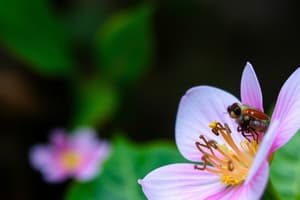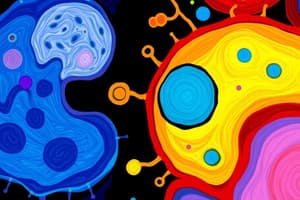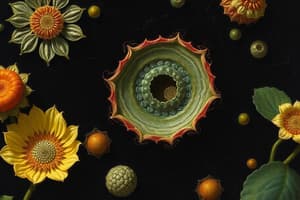Podcast
Questions and Answers
Living organisms share features like movement, respiration, sensitivity, nutrition, excretion, reproduction, and ______.
Living organisms share features like movement, respiration, sensitivity, nutrition, excretion, reproduction, and ______.
growth
Plant cells have unique organelles like the cell wall, vacuole, and ______ responsible for photosynthesis.
Plant cells have unique organelles like the cell wall, vacuole, and ______ responsible for photosynthesis.
chloroplasts
Eukaryotes (animal cells) have membrane-bound organelles like nuclei and mitochondria, while prokaryotes (viruses, bacteria) lack ______.
Eukaryotes (animal cells) have membrane-bound organelles like nuclei and mitochondria, while prokaryotes (viruses, bacteria) lack ______.
these
Pathogenic bacteria like pneumococcus cause diseases such as pneumonia, while useful bacteria like lactobacillus bulgaricus are used in ______-making.
Pathogenic bacteria like pneumococcus cause diseases such as pneumonia, while useful bacteria like lactobacillus bulgaricus are used in ______-making.
Fungi have structures like plant cells but lack chloroplasts, carry out saprotrophic nutrition by secreting enzymes onto dead ______.
Fungi have structures like plant cells but lack chloroplasts, carry out saprotrophic nutrition by secreting enzymes onto dead ______.
A fermenter is a vessel used for fermentation reactions, optimized with a cooling jacket, temperature and pH monitors, stirring paddles, aeration unit, and nutrient supply. Selective breeding involves breeding animals or plants over generations for desired traits, such as high milk yield in dairy cows or specific colors in flowers. Genetic engineering involves manipulating genetic material, like producing human insulin in bacterial cells by inserting the insulin gene into a bacterial ______.
A fermenter is a vessel used for fermentation reactions, optimized with a cooling jacket, temperature and pH monitors, stirring paddles, aeration unit, and nutrient supply. Selective breeding involves breeding animals or plants over generations for desired traits, such as high milk yield in dairy cows or specific colors in flowers. Genetic engineering involves manipulating genetic material, like producing human insulin in bacterial cells by inserting the insulin gene into a bacterial ______.
Plants can be genetically modified for traits like frost resistance, extended shelf life, weed killer resistance, health benefits (e.g., Golden Rice with vitamin A), or producing vaccines (e.g., tobacco plants for hepatitis antigens). Transgenic organisms have genes transferred from one species to another, such as goats with spider genes to produce spider silk in their ______.
Plants can be genetically modified for traits like frost resistance, extended shelf life, weed killer resistance, health benefits (e.g., Golden Rice with vitamin A), or producing vaccines (e.g., tobacco plants for hepatitis antigens). Transgenic organisms have genes transferred from one species to another, such as goats with spider genes to produce spider silk in their ______.
Photosynthesis occurs in chloroplasts of plant cells, producing glucose and oxygen from carbon dioxide and water using ______.
Photosynthesis occurs in chloroplasts of plant cells, producing glucose and oxygen from carbon dioxide and water using ______.
Leaf structure adaptations for photosynthesis include a waxy cuticle to prevent water loss, palisade mesophyll for chloroplast-rich photosynthesis, spongy mesophyll with air spaces for gas ______.
Leaf structure adaptations for photosynthesis include a waxy cuticle to prevent water loss, palisade mesophyll for chloroplast-rich photosynthesis, spongy mesophyll with air spaces for gas ______.
Lactobacillus bulgaricus bacterium is used in yogurt making to break down lactose into lactic acid, giving yogurt its distinctive ______.
Lactobacillus bulgaricus bacterium is used in yogurt making to break down lactose into lactic acid, giving yogurt its distinctive ______.
An enzyme is a biological catalyst with specific active sites, affected by temperature and pH for optimal ______.
An enzyme is a biological catalyst with specific active sites, affected by temperature and pH for optimal ______.
Flashcards are hidden until you start studying
Study Notes
- Key point: The video covers IGCSE Biology material in great detail, aiming to help students achieve a grade 9.
- Revision guides are available for purchase online, compiled with perfect questions and answers.
- Living organisms share features like movement, respiration, sensitivity, nutrition, excretion, reproduction, and growth.
- Plant and animal cells share organelles like cell membranes, cytoplasm, nuclei, ribosomes, and mitochondria.
- Plant cells have unique organelles like the cell wall, vacuole, and chloroplasts responsible for photosynthesis.
- Eukaryotes (animal cells) have membrane-bound organelles like nuclei and mitochondria, while prokaryotes (viruses, bacteria) lack these.
- Bacterial cells have a cell wall, slime capsule, flagella for movement, circular chromosome (nucleoid), plasmids, cytoplasm, cell membranes.
- Pathogenic bacteria like pneumococcus cause diseases such as pneumonia, while useful bacteria like lactobacillus bulgaricus are used in yogurt-making.
- Viruses are smaller than bacteria, made of protein coat and DNA/RNA, always pathogenic (e.g., flu virus, HIV).
- Protists are diverse organisms with some resembling plant cells (algae, kelp) and others animal cells (like amoeba).
- Fungi have structures like plant cells but lack chloroplasts, carry out saprotrophic nutrition by secreting enzymes onto dead matter.
- Yeast is a type of fungi used in beer and bread-making due to its anaerobic respiration capabilities.
- Five kingdoms include plants, animals, protists, bacteria, and fungi, each storing carbohydrates differently (glycogen, starch).
- Cellular organization hierarchy: cell -> tissue -> organ -> organ system -> organism.
- Organ systems in the body include the digestive, endocrine, reproductive, circulatory, respiratory, nervous, excretory systems.
- Enzymes are biological catalysts with specific active sites, affected by temperature and pH for optimal activity.
- Diffusion, osmosis, and active transport are key processes in cellular transport mechanisms.
- Photosynthesis occurs in chloroplasts of plant cells, producing glucose and oxygen from carbon dioxide and water using sunlight.
- Limiting factors in photosynthesis include carbon dioxide levels, light intensity, and temperature.
- Leaf structure adaptations for photosynthesis include a waxy cuticle to prevent water loss, palisade mesophyll for chloroplast-rich photosynthesis, spongy mesophyll with air spaces for gas exchange.- Lactobacillus bulgaricus bacterium is used in yogurt making to break down lactose into lactic acid, giving yogurt its distinctive flavor.
- A fermenter is a vessel containing microorganisms for fermentation reactions, optimized with a cooling jacket, temperature and pH monitors, stirring paddles, aeration unit, and nutrient supply.
- Selective breeding involves breeding animals or plants over generations for desired traits, such as high milk yield in dairy cows or specific colors in flowers.
- Genetic engineering involves manipulating genetic material, like producing human insulin in bacterial cells by inserting the insulin gene into a bacterial plasmid.
- The recombinant plasmid in genetic engineering is created when a different gene is inserted, and the bacterial plasmid acts as a vector to transport biological material.
- Plants can be genetically modified for traits like frost resistance, extended shelf life, weed killer resistance, health benefits (e.g., Golden Rice with vitamin A), or producing vaccines (e.g., tobacco plants for hepatitis antigens).
- Transgenic organisms have genes transferred from one species to another, such as goats with spider genes to produce spider silk in their milk.
Studying That Suits You
Use AI to generate personalized quizzes and flashcards to suit your learning preferences.




